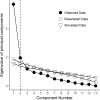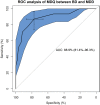The Factor Structure of the Mood Disorder Questionnaire in Tunisian Patients
- PMID: 33029185
- PMCID: PMC7536729
- DOI: 10.2174/1745017902016010082
The Factor Structure of the Mood Disorder Questionnaire in Tunisian Patients
Abstract
Background: The Mood Disorder Questionnaire (MDQ) is a frequently used screening tool for the early detection of Bipolar Disorder (BD), which is often unrecognized or misdiagnosed at its onset. In this study, data from Tunisia has been used to evaluate the psychometric properties of the Arabic MDQ.
Methods: The sample included 151 patients with a current major depressive episode. The Arabic adapted version of the Structured Clinical Interview for DSM-IV-TR was used to formulate a diagnosis, yielding 62 patients with BD and 89 with unipolar Major Depressive Disorder (MDD). Principal component analysis with parallel analysis was used to establish the spontaneous distribution of the 13 core items of the MDQ. Confirmatory Factor Analysis (CFA) was used to check the available factor models. Receiver Operating Characteristic (ROC) analysis was used to assess the capacity of the MDQ to distinguish patients with BD from those with MDD.
Results: Cronbach's α in the sample was 0.80 (95%CI: 0.75 to 0.85). Ordinal α was 0.88. Parallel analysis suggested two main components, which explained 59% of variance in the data. CFA found a good fit for the existing unidimensional, the two-factor, and the three-factor models. ROC analysis showed that at a threshold of 7, the MDQ was able to distinguish patients with BD from those with MDD with extraordinary negative predictive value (0.92) and a positive diagnostic likelihood ratio of 3.8.
Conclusion: The Arabic version of the MDQ showed good measurement properties in terms of reliability, factorial validity and discriminative properties.
Keywords: Bipolar disorder; Confirmatory factor analysis; Early detection; Factorial validity; Hypomania/mania; Mood Disorder Questionnaire.
© 2020 Ouali et al.
Figures





References
-
- Merikangas K.R., Jin R., He J.P., Kessler R.C., Lee S., Sampson N.A., Viana M.C., Andrade L.H., Hu C., Karam e.g., Ladea M., Medina-Mora M.E., Ono Y., Posada-Villa J., Sagar R., Wells J.E., Zarkov Z. Prevalence and correlates of bipolar spectrum disorder in the world mental health survey initiative. Arch. Gen. Psychiatry. 2011;68(3):241–251. doi: 10.1001/archgenpsychiatry.2011.12. - DOI - PMC - PubMed
-
- Hoyle S., Elliott L., Comer L. Available screening tools for adults suffering from bipolar affective disorder in primary care: An integrative literature review. J. Am. Assoc. Nurse Pract. 2015;27(5):280–289. - PubMed
